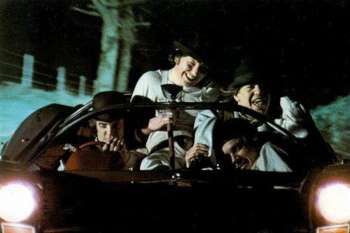Anthony Burgess’ novel A Clockwork Orange (and the Stanley Kubrick film based upon it) made a bold statement about what our technology should and shouldn’t do. Forcing citizens to obey the law is immoral, asserts Burgess. Once you’ve taken away our freedom of choice, you’ve taken away our souls.
But technology isn’t always about giving us more freedom to do things we couldn’t do before. Our lives are stuffed to the gills with choice, and there’s such a thing as too much of it. Sometimes technology can help precisely by taking away our freedoms. Small, inconvenient, and irritating freedoms.
 For instance: speed limits.
For instance: speed limits.
Most of us have precisely two feelings about speed limits. One, they’re too low; and two, it’s annoying to have to pay attention to them. Oh, we recognize in the back of our minds that speed limits are necessary, that speed limits act as a reminder and a deterrent and in the long run save lives.
But it’s difficult and irritating to pay attention to them. The signs are standardized across the nation so they’re easily recognizable, but you’re never quite sure when you’re going to see one. When you travel to another state, you never know what the interstate speed limit is. As a result, most of the speeding tickets we get — most of the ones I’ve gotten at least — are a result of ignorance, not disobedience. We want to obey the law, we really do. It’s just not easy enough.
So here’s a perfect opportunity to use the power of information technology to put our insignificant freedoms on pause.
What if the Department of Transportation created a national database of speed limit information tied to GPS coordinates? And what if every car was equipped with a specialized GPS unit that could tap into this database and therefore tell you what the proper speed limit was at all times?
Your car would then be able to sense when you were approaching or breaking the speed limit. Perhaps the dashboard could signal you with a flashing light or an audible chime. Or maybe, like videogame controllers, the car could give “force feedback” to make pressing the accelerator noticably more difficult the faster you’re going. Perhaps ultimately you might choose for the car to simply not let you exceed the speed limit — or to cap you at ten miles an hour over.
The first objection you’re going to raise is that we’d start seeing a new breed of Road Warrior out there hacking cars and telling you the speed limit is 55 in a 25 zone. (William Gibson’s novel Virtual Light begins with a scene of this kind of automotive hacking.) So security would obviously be paramount. I’m willing to bet that we could come up with a relatively hack-proof method of securing car GPS units and speed limit transmissions.
Then, of course, the question arises of what happens when you’re driving through a tunnel or a hurricane and the GPS information isn’t available. Well, there’s a simple solution for that: store a cached copy of the speed limit database locally in the car. (If that’s not a practical solution because of storage limitations, then certainly the car should be able to hold speed limit information within, say, a 200-mile radius.)